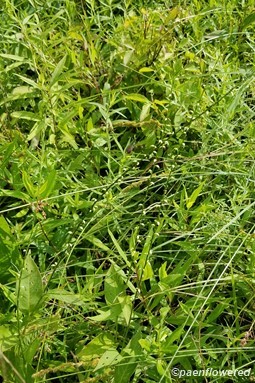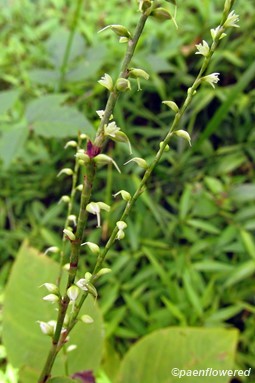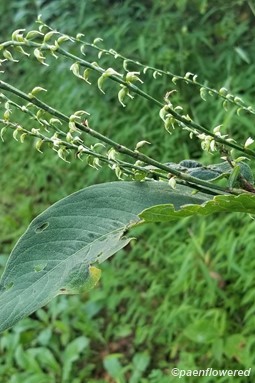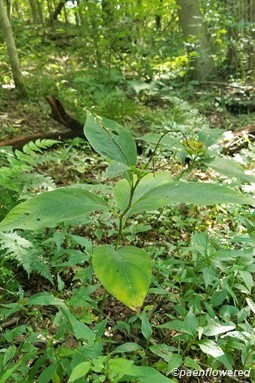Persicaria virginiana
Native jumpseed with whitish inconspicuous flowers on a long, thin stalk
Persicaria virginiana jumpseed
Add to MyPlants View Locations
This native annual or perennial member of the buckwheat family is one of the few flowers you will find blooming in the shaded woodlands from July to October in this area. The long thin flower stalk often arches beside or across hiking trail. The stalk may be up to two feet long. Normally there is a single flower spike, but occasionally it may form branches.
This is not a spectacular wildflower but is abundant. The tiny white or greenish-white (sometimes pink) flowers are spaced at intervals along the long stem and hug that stem closely. Though difficult to see, the flowers have four tiny tepals (a combination of petals and sepals that have a similar appearance). Because of the small flowers, I place this species in my "be they ever so humble" category. The small seeds retain two persistent, hooked and downward-pointing styles. When the seeds are mature, pressure on the style will cause them to jump off the plant - giving the species one of its common names.
The leaves are broadly egg or lance-shaped and hairy. Younger leaves may have a dark V-shaped marking in the center. These leaves are generally larger than those of similar species. There is a sheath where leaves join the stem - a characteristic of the buckwheat family. This sheath is finely hairy and fringed with bristles.
The Virginia knotweed is found throughout most of the eastern half of North America but seems to be more abundant in the northern part of its range. It is found in every county of Pennsylvania. It is also called by the common names woodland knotweed and Virginia smartweed.
Native Americans used a preparation of the leaves of this plant with the bark of the honey locust tree to treat whooping cough. Ornamental garden cultivars are available, many with colorful or variegated leaves. On of the most popular is known by the name of "painter’s palette".
Habitat & Range
Common in moist woodlands, floodplains and clearings.
Present throughout the state.
| EMP: | FAC |
|---|---|
| NCNE: | FAC |
Phenology
Flowers July to October.
Characteristics
Height 2-3 feet
Plant Codes
S-rank: S5 (Secure)
G-rank: G5 (Secure)
Persicaria virginiana jumpseed
Synonyms: Polygonum virginianumAdd to MyPlants View Locations














.JPG?v=638217088360000000)

.jpg?v=638921765700000000)

Comments
Have you spotted this plant in your area? We'd love to hear about your experience! Share your comments or questions about the plant below. Comments are moderated before posting.